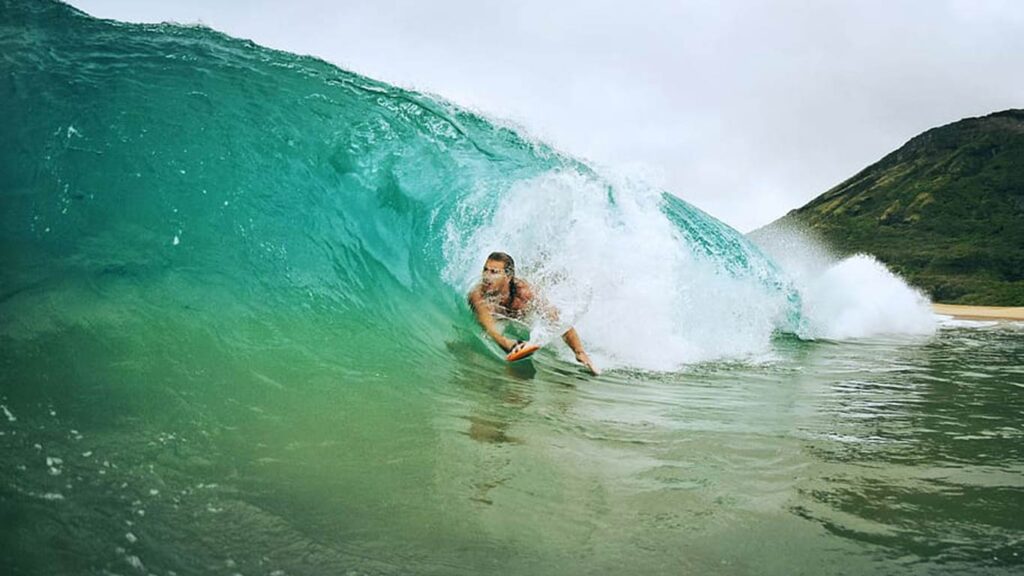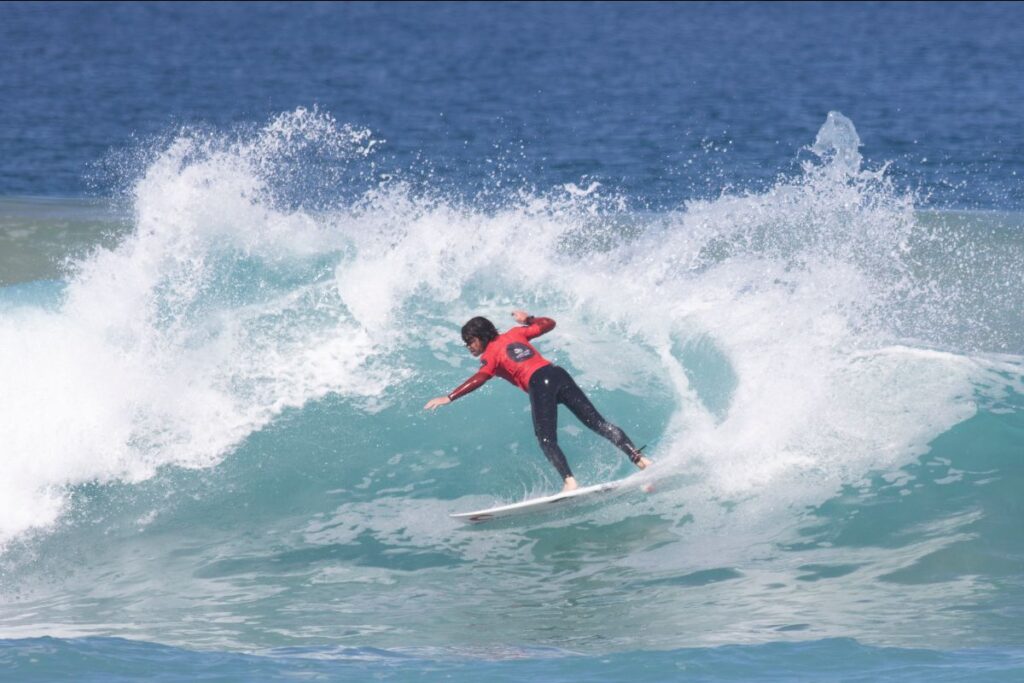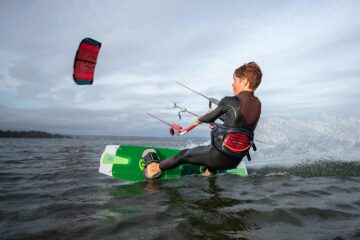Have you ever wanted to feel the thrill of riding a wave without a surfboard? Body surfing allows you to catch and ride waves using only your body.
By swimming parallel to the beach, timing your entry just right, and angling your body to gain speed, you can catch a wave and get an exhilarating ride toward shore.
While less equipment is needed, body surfing still requires skill and awareness to stay safe. Give this classic ocean activity a try for a fun new challenge!
What Is Body Surfing?
Body surfing is riding waves without a board. You use your body to catch and ride the wave to the shore. It’s like swimming into a wave and letting it push you along. You need swim fins for your feet to help catch waves better. It’s a fun and simple way to enjoy the ocean.

Body Surfing Basics
Body surfing is fun! You ride waves using your body instead of a surfboard. Let’s learn what you need and how to do it safely.
What equipment do you need?
- Wetsuit: Keeps you warm in cold water.
- Fins: Help you swim fast to catch waves.
- Handboard (optional): Makes riding waves easier.
Choosing the right beach:
- Look for beaches with lifeguards.
- Waves should be not too big, not too small.
- Sandy beaches are best because they’re safer than rocky ones.
Ocean safety tips:
- Always swim where a lifeguard can see you.
- Nobody surfed alone. Have a buddy.
- Learn about rip currents. They can pull you away from shore.
How to read waves:
- Watch how waves break. You want waves that roll nicely, not too fast.
- The best waves for body surfing break gently and not all at once.
- Practice makes perfect. The more you watch, the better you’ll get at choosing good waves.
Remember, body surfing is about having fun and being safe. Always respect the ocean and enjoy your time in the water!
How To Body Surf?
Ready to feel the ocean’s power and carve down waves like a dolphin? Bodysurfing is your ticket to aquatic thrills without needing a fancy board. Let’s dive in!
Step 1: Gear Up (But Not Too Much!)
- Beach buddy: This is not a solo adventure. Grab a friend or parent to watch out for you.
- Swimsuit: Duh! One that fits snugly is best.
- Sunscreen: Protect your skin from the sun’s angry rays.
- Fins (optional): Can help you catch waves faster, but not essential.
Step 2: Beach Basics (Safety First!)
- Find a calm beach: Look for gentle waves and a sandy bottom, avoiding rocky areas.
- Ask a lifeguard: They’re there to help and know the best spots.
- Respect the ocean: Waves can be powerful, so be cautious and never go beyond your comfort level.
Step 3: Catch That Wave!
- Tread water: Get comfortable in the water and practice looking over your shoulder for waves.
- Spot your wave: Look for a rolling wave that’s just starting to break.
- Paddle like crazy: As the wave approaches, paddle hard towards shore to gain momentum.
- Dive under or jump over: As the wave lifts, dive under it or jump over it to avoid getting pummeled.
Step 4: Ride the Wave!
- Superman poses: Stretch your arms and legs out straight like you’re flying.
- Feel the wave: Keep your body flat and relaxed, letting the wave carry you.
- Lean and turn: To turn, lean your body in the direction you want to go.
- Have fun! Whoop, holler, and feel the rush of the ocean!
Step 5: Wipeout Woes (It Happens!)
- Don’t panic: Relax and stay afloat.
- Surface slowly: Look around before coming up to avoid other surfers.
- Paddle back out: Try again! Remember, practice makes perfect.
Pro Tips:
- Start with smaller waves and progress to bigger ones as you get comfortable.
- Don’t be afraid to ask experienced body surfers for tips.
- Respect other surfers and share the waves.
- Most importantly, have fun and enjoy the ride!
With these steps and a dash of courage, you’ll be riding waves like a pro in no time.

Is Body Surfing Dangerous?
Yes, body surfing can be dangerous, but you can stay safe by knowing a few important things.
Why it can be risky:
- Waves and Currents: Strong waves and rip currents can pull you underwater or away from shore.
- Contact with the Bottom: You might hit the sandy bottom or rocks, which can cause injuries.
- Collisions: You could bump into other swimmers, surfers, or sea creatures.
Staying Safe:
- Always swim where lifeguards can see you.
- Learn about the ocean, like how to spot and escape rip currents.
- Use fins for better control and to swim strongly.
- Never body surfs alone. Have a buddy with you.
How To Get The Surfer Body?
Getting a surfer body means being fit, strong, and flexible. Here’s how you can do it:
Exercise Regularly:
- Swimming: Builds shoulder and back muscles, and improves your stamina.
- Push-ups and Planks: Strengthen your core and arms, important for paddling and balance.
- Squats and Lunges: Improve leg strength for standing up on the board and maintaining balance.
Eat Healthy:
- Eat lots of fruits, vegetables, lean proteins, and whole grains.
- Stay hydrated with water, especially before and after workouts.
Surfing:
The best way to get a surfer body is by surfing regularly. It’s a full-body workout.
Flexibility:
Stretch daily to improve flexibility, which helps with surfing movements and prevents injuries.
Rest:
Your body needs time to recover. Make sure you get enough sleep.
By following these tips, exercising, eating right, and surfing, you’ll be on your way to getting that surfer body.
Wrap Up
Body surfing is an exhilarating and pure way to experience the ocean’s power. It’s a fun, accessible activity that enhances your connection with nature, improves fitness, and offers a unique thrill. With safety in mind, anyone can enjoy the simplicity and joy of riding waves with just their body.
FAQs
Body surfing can be challenging for beginners, especially learning to catch waves and timing. With practice, understanding wave patterns, and proper technique, it becomes easier and enjoyable.
People body surf for the thrill of riding waves without equipment, to connect closely with the ocean, and to enjoy a simple, pure form of wave riding that’s accessible and fun.
The ideal body position for body surfing is horizontal, facing the shore. Arms extended forward, one hand leading to steer, and legs kicking for propulsion and balance on the wave.
Body surfing is simpler in terms of equipment—no board needed—but catching waves and riding them properly requires skill and practice. It’s different from board surfing but not necessarily easier.
Yes, body surfing burns calories. It’s an active, full-body workout involving swimming, kicking, and balancing on waves, which increases heart rate and calorie burn, making it a great exercise.




